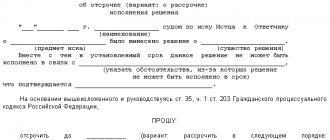Warning in administrative law
The legislation of the Russian Federation is aimed at preventing all types of offenses.
The main goal of all types of administrative measures is to reduce their number. The preventive measures used are aimed at both offenders and persons who may become them. What is a warning? First of all, a warning is an administrative penalty. Article 3.3. The Code classifies it as one of the main types of punishment. It cannot be used as an additional one. In the rank of administrative measures, this is the mildest punishment. Its consequences for the punished are minimal. Features of a warning as a type of punishment:
- warning is a type of liability that applies to both individuals and legal entities;
- the content of the warning is official censure;
- An administrative warning cannot be applied when the offense has signs of high social danger and is committed repeatedly;
- A warning is used only as a primary punishment.
Issue form
A warning as a type of administrative punishment is always issued in writing. Citizens often confuse verbal comments from law enforcement officers or supervisory authorities with the imposition of real penalties.
Is a verbal warning an administrative penalty? Of course not. A verbal reprimand will not be a punishment. Indeed, officials can release the offender from liability and limit themselves to conversation. They are authorized to classify the offense as minor.
The logical question is: in what form is a warning issued? A protocol on an administrative offense is not drawn up. The violator is given a second copy of the decision against signature. If there is a third party, a copy is made for them. Copies can also be sent by registered mail within three days from the date of the decision.
Conditional administrative warnings are divided into the following types:
- a general warning, which states public rejection of the violation and calls for compliance with the law in the future (a protocol is issued indicating the content of the violation);
- a special warning with the use of measures limiting a repeat offense (for example, a weapon, equipment, or special means with which the violation was committed is confiscated from a citizen or organization).
Preparing to issue a written warning
Collecting information about the problem
Before creating a written warning, it is necessary to collect all the necessary information regarding the employee and the issue of concern. Analysis of the information will allow us to assess the feasibility of such a decision and write a detailed, effective warning.
The following information is assessed: • dates and times of any violations. • any conversations or previous verbal warnings about this problem. • old documents that were signed by the employee, reflecting his agreement with the company's terms, as well as illustrating his violation of them.
Conversation with an employee
Before issuing a written warning, a confidential conversation is held with the offender. The meeting allows you to better understand the situation and make a fair decision before such an important step. The conversation may reveal that the issue was a misunderstanding and no further action is required.
Confirmation of the person responsible for resolving the issue
Determine whether it is the employee's immediate responsibility to issue warnings. In large organizations, it is not always clear who should take on this responsibility, especially if the employee has several supervisors.
As a rule, such “letters” are issued by the immediate manager, but in some cases the decision to issue a warning may be made at a meeting of a group of managers.
Writing a warning
1. While requirements may vary among organizations, there are a number of common elements included in every formal written warning. To create an informative and effective written warning, it is important to: • Include the names of all parties involved. • Describe the nature of the offense. • Specify the date and time of the violation. • Explain details about pre-issued warnings, period, timing and employees involved. • Include instructions given to the employee to correct the situation. • Write down the stated consequences of this violation, as well as the consequences of future problems.
2. Be as specific as possible. Clear and concise details of the warning will help accurately convey the complaint and allow the employee to correct the behavior more quickly to avoid future offenses.
Warnings should make it clear what will happen if the employee's behavior is not corrected. For example: “If a repeat violation occurs, a final warning will be issued before termination.”
3. Deliver the written warning in person. Even though it is written, sending it by email or other means is pointless, since the seriousness of the designated incident is completely lost.
By conveying a warning during a private meeting with an employee, there is an opportunity to once again set the right emphasis and answer questions. This is especially important if the employee is productive and there is a goal to keep him in the company. Having started the meeting, you can point out the positive aspects of his work, and only then focus on the negative course of events.
4. Make sure the employee understands the warning. Once the warning is written and given to the subordinate, it is important to discuss its terms (duration, reason, expected behavior, and time frame for correction).
Most written warnings are signed, and prior agreement to the terms of the agreement is taken. It is humane if the employee is allowed to challenge such decisions. Whatever one may say, it is impossible to be immune from an initially incorrect interpretation of events and information.
Example of a written warning
“To the leading specialist of the delivery service Artemy Terekhov
Previously, conversations were held with you to restore discipline. Links to the work done can be found in the appendix. (Reference is made to the above disciplinary proceedings in which charges of insubordination were made.) You repeatedly left a work truck on the side of the road near your home after making late deliveries to customers. You did not respond to requests and warnings about the need to park in a protected area, arguing your behavior with the remoteness of the parking lot and the special significance of the orders being executed.
On the night of March 27, 2021, you repeatedly refused to comply with this work condition. As a result, the battery of a truck parked in the yard was stolen at night. This fact caused financial damage to the company for the purchase of a new battery. (The employee has been identified and the date, time, place and nature of the crime is clearly stated.)
You have admitted your guilt and must clearly understand that failure to comply is considered a serious offense and cannot be tolerated further. (The employee stated that he considered this a serious matter.) You are hereby warned that if you park a work vehicle in an unauthorized area during your probationary period, you will be subject to more severe disciplinary action, up to and including termination.
You must refrain from committing any acts of misconduct during the course of your employment with this company. This warning is valid for 6 months from the date of this document. (The employee also explained what actions were required of him to correct the situation.)
Sincerely, Very Annoyed Boss. I know and understand the contents of this warning and have received a copy of it. Employee’s signature ________________________ Date: ______________ Witness Signature: _________________________________"
Measures
The administrative warning measures that the police can use look completely different. They are not a punishment, but a measure of administrative coercion. Used for the following purposes:
- directly to prevent crime;
- to limit circumstances that threaten the public and personal safety of citizens.
Administrative warning measures are restrictions of an administrative and legal nature, administrative and compulsory actions against a citizen or official.
The first group of measures is used to prevent immediate threats or undesirable consequences for people and society. For example, closing streets or sections of the road where accidents occurred, landslides, or downed power lines.
The second group of measures applies to citizens with antisocial behavior. An example is maintaining administrative supervision over those released from prison.
Criminal liability
Criminal legal liability occurs for individuals for the most serious types of offenses - crimes.
The types and amount of punishments are regulated by the Criminal Code, the procedure for bringing to justice is the Criminal Procedure Code, and the procedure for executing punishments is the Criminal Executive Code.
Crimes cause the greatest harm to society and the state; they are directed against such civil values as life, health, integrity of the state, property, sexual and personal integrity.
Therefore, the sanctions for criminal liability are the most severe - imprisonment, correctional labor, fines, confiscation of property.
The legislator has established two most important restrictions for bringing to criminal liability:
- age (from 16 years old, and for murder, grievous bodily harm, assault, robbery, theft - from 14 years old),
- sanity (insane persons may be subjected to compulsory treatment in specialized institutions).
In addition, insanity excludes, in principle, any legal liability.
Are you at risk of criminal liability?
Get advice from a criminal lawyer! Confidentially.
To get a consultation
Authorized persons
Only specially authorized officials can use administrative penalties in their work. Their circle is clearly defined by the Code of Administrative Offenses of the Russian Federation. This list includes:
- commissions on juvenile affairs;
- tax authorities and tax police authorities;
- internal affairs bodies;
- customs and export control authorities;
- border guard agencies and troops;
- state labor inspectorates;
- bodies of State Epidemiological Surveillance, fisheries protection, state environmental control;
- state supervision authorities, transport inspection;
- FAS, Rospotrebnadzor, state housing inspection bodies and many others.
In total, more than 60 bodies and officials can initiate the issuance of an administrative warning.
Both administrative punishment and disciplinary action
Before formulating how to issue a warning to an employee, let us clarify: employees, being officials, can be held administratively liable, and by decision of the court or authorized regulatory bodies they can be punished for violations of the law.
If the offense committed contains signs of both an administrative and a disciplinary violation, the employer has the right to involve the employee also in accordance with the rules of the Labor Code of the Russian Federation. It is also possible to hold a subordinate financially liable if his actions caused damage to the company. A sample warning to an employee for violation of official duties or discipline will be needed if such an option for disciplinary punishment is prescribed:
- in federal legislation (for example, for judges - Article 12.1 of the Law of the Russian Federation of June 26, 1992 No. 3132-1);
- in the charters (Disciplinary Charter of the Customs Service of the Russian Federation, approved by Decree of the President of the Russian Federation of November 16, 1998 No. 1396, general military regulations of the Armed Forces of the Russian Federation, approved by Decree of the President of the Russian Federation of November 10, 2007 No. 1495, Disciplinary Charter of the Internal Affairs Bodies of the Russian Federation, approved by Decree of the President RF dated October 14, 2012 No. 1377);
- in the provisions (so far the law only provides for the provision on discipline of railway transport workers of the Russian Federation, approved by Decree of the Government of the Russian Federation of August 25, 1992 No. 621).
Reasons for use
In what cases is an administrative warning established:
- a citizen or legal entity commits an offense for the first time;
- the offense did not lead to harm to the life and health of people, objects of the surrounding flora and fauna, or cultural heritage;
- there is no threat of emergency situations, nothing threatens the security of the state;
- there is no property or material damage.
Consequently, a warning as a type of administrative punishment is issued only for minor offenses.
When administrative measures can be applied
Let us remind you that an administrative warning can be applied to both individuals and legal entities.
If the decision on an administrative warning has entered into force, the person is considered subject to administrative punishment. In some exceptional cases, administrative measures may be applied to the violator. They are usually aimed at ensuring the execution of administrative punishment. This could be an inspection of things and goods, document verification, removal from driving, driving, and others.











